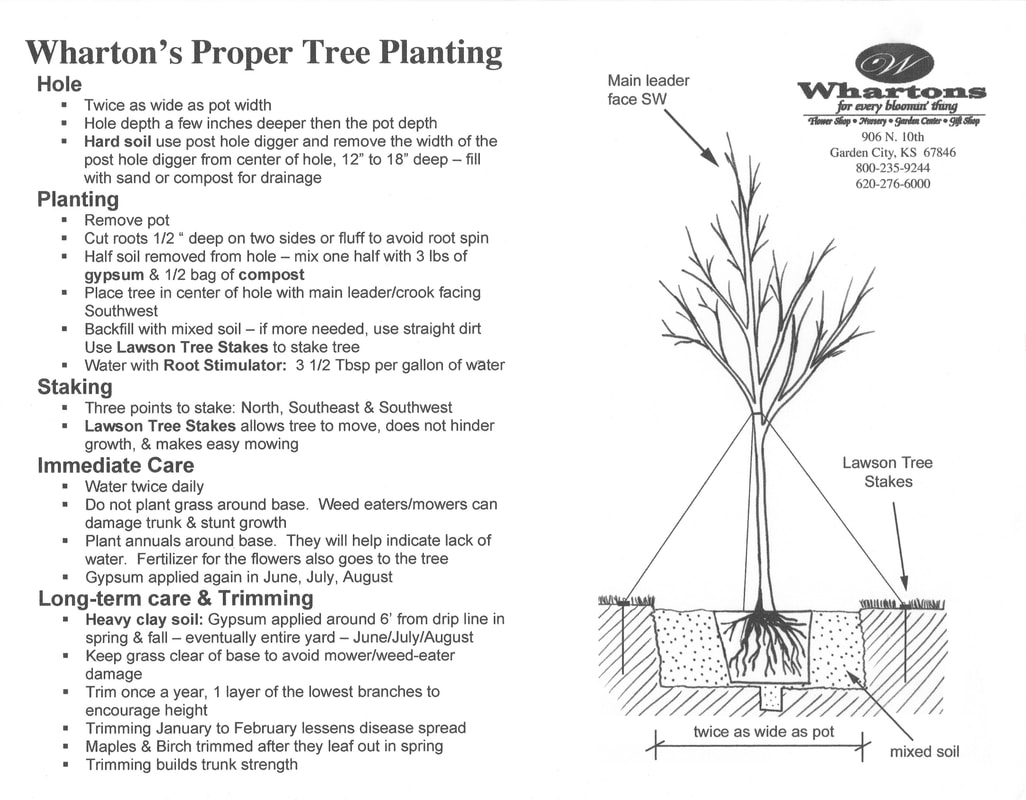Shade Trees
Guaranteed for 90 days
Time to plant!
One extra year of growth planting now.
Favorites marked with an asterisk (*)
|
Greater than 2 foot of typical growth per year
Elm Trees (Ulmus spp.) National Elm Trial (Elm species information) American Elm Varieties Chinese Elm Varieties Elm Parent Tree Chart 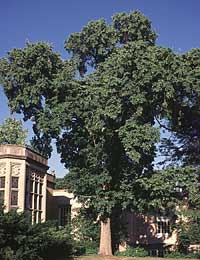
Accolade Elm*
(Ulmus japonica x wilsoniana’ Morton’) is characterized by arching limbs and a graceful vase shape like that of the classic American Elm. Its glossy dark green foliage changes to yellow in the fall and is resistant to elm leaf beetle feeding as well as Dutch Elm Disease and Phloem Necrosis. This fine cultivar derives from an outstanding specimen tree growing at Morton Arboretum (pictured). Heat and drought resistant, this Chicagoland Grows introduction also shows good nursery form and appears to be one of the best of the hybrid elms. The parent tree, according to information released by Chicagoland Grows, Inc., is a hybrid of U. japonica x U. wilsoniana. 
Allee Elm
This tall graceful tree has season long interest, with beautiful rich green summer foliage that changes to yellow in autumn, and in some years to pink/red color. The bark exfoliates at a young age, in puzzle-like patterns exposing rich shades of gray, green, brown and orange-brown. A tough, fast growing tree and tolerant of urban situations. Resistant to Dutch elm disease. Voted 2003 Urban Tree of the Year by the Society of Municipal Arborists. 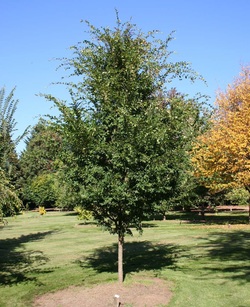
Athena Classic
Zone: 5 Height: 30' Spread: 35' Shape: Broadly rounded Foliage: Medium green, glossy Fall Color: Yellowish DISEASE TOLERANCE: Dutch Elm Disease and phloem necrosis Bark of a mature tree is a mosaic of orange, tan, and gray patches, giving it as much interest in winter as in summer. The canopy is tightly formed. Discovered by Dr. Michael Dirr of University of Georgia, Athens. 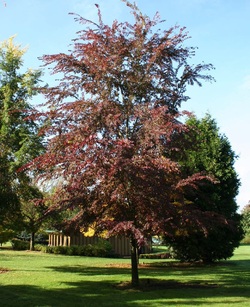
Frontier Elm*
Zone: 5 Height: 40' Spread: 30' Shape: Vase shaped oval Foliage: Glossy green Fall Color: Burgundy DISEASE TOLERANCE: Dutch Elm Disease and Phloem Necrosis ‘Frontier’ features beautiful reddish purple to burgundy fall color which is particularly long lasting. A U.S. National Arboretum introduction, it is a hybrid of U. carpinifolia and U. parvifolia. 
Emerald Sunshine
Beauty meets utility in this heat and drought tolerant elm. Its adaptability and mannerly, vase-shaped growth habit result in an easily grown, premium shade tree. Highly resistant to disease and insect attack, it adapts to varied growing conditions and pH levels, and thrives in tough urban settings. True to its name, Emerald Sunshine® Elm thrives in the hot summer sun while casting cool green shade. Leaves retain their fresh, green appearance through the hot days of summer, when drying winds cause damage to less heat-adapted trees. Strongly textured foliage emerges with red tints and matures to a deep, rich green. Fall color is rich yellow, sometimes with purple tints on the tips and along the margins. Leaves are also highly resistant to the feeding of elm leaf beetles, according to university researchers conducting a 10-year nationwide performance trial. In addition to warding off insect attacks, this versatile performer resists Dutch Elm Disease and Phloem Necrosis. Selected on the arid plains of western Oklahoma by plantsman and elm enthusiast Steve Bieberich, this compact, carefree elm was chosen as the best performing plant grown from Ulmus propinqua seed collected in China. Maturing smaller than most elms, it develops a vase shaped canopy as it reaches about 30 feet in height with a spread of about 25 feet. A strong central leader and upright, symmetrical and mannerly growth habit make it an easy-care tree in the nursery as well as in the landscape and on the street. Hardiness is USDA Zone 5. 
Patriot Elm
Zone: 4 Height: 50’ Spread: 40’ Shape: Stiffly upright, narrow vase shape Foliage: Dark green Fall Color: Yellow DISEASE TOLERANCE: Dutch ElmDisease and phloem necrosis This National Arboretum introduction features stiffly ascending branches, resulting in a narrower vase shaped crown than most elm cultivars. Foliage is especially dark green. A complex hybrid derived from Ulmus wilsoniana, U. pumila, U. carpinifolia, and U. glabra. 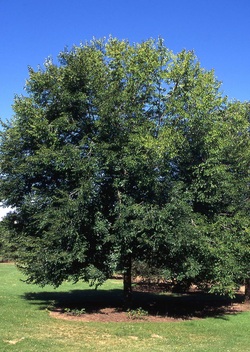
Pioneer Elm
Height: 50' Spread: 50' Zone: 5 Shape: Rounded Foliage: Dark green Fall Color: Yellow DISEASE TOLERANCE: Dutch elm disease and phloem necrosis Introduced by the USDA Nursery Crops Lab, Pioneer Elm is extremely vigorous and disease resistant. It forms a rounded, spreading crown suitable for parks and campus setting. A hybrid of U. glabra x U. carpinifolia. 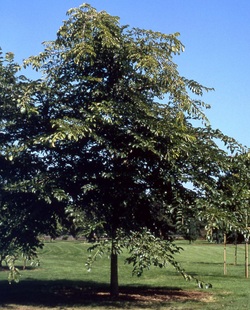
Prospector Elm
Zone: 4b Height: 40' Spread: 30' Shape: Vase shaped Foliage: Deep green, glossy Fall Color: Yellow INSECT RESISTANCE: elm leaf beetle DISEASE TOLERANCE: Dutch Elm Disease and phloem necrosis This cultivar forms a broadly vase shaped crown at an early age, and provides the form and toughness of the American Elm without its problems. Widely adaptable to climatic extremes. A National Arboretum introduction. 
Valley Forge
Elm Zone: 4 Height: 70’ Spread: 70’ Shape: Broadvase shaped with arching limbs Foliage: Medium green Fall Color: Yellow DISEASE TOLERANCE: Dutch Elm Disease This National Arboretum introduction has tested best for Dutch Elm Disease tolerance, bringing hope for the return of the American elm. Fast growing but a little wild in the nursery, it matures to form a stately vase shaped crown. 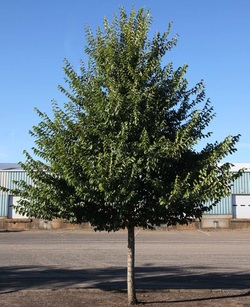
New Horizon Elm
Zone: 4 Height: 55’ Spread: 40’ Shape: Upright oval, slightly arching Foliage: Dark green Fall Color: Yellow DISEASE TOLERANCE: Dutch elm disease and phloem necrosis This cold tolerant hybrid elm was developed in a disease resistance program at the University of Wisconsin. Easy to grow, straight, and symmetrical in the nursery, it becomes a rugged street tree. 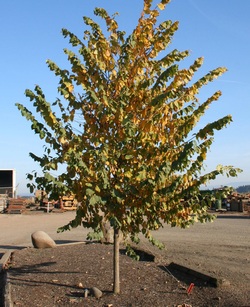
New Harmony Elm
Zone: 4 Height: 70’ Spread: 65’ Shape: Vase shaped with arching limbs Foliage: Medium green Fall Color: Yellow DISEASE TOLERANCE: Dutch Elm Disease Introduced by the U.S. National Arboretum, this tree features the classic vase shape of the American elm along with a high level of disease tolerance. Vigorous growing and slightly narrower than Valley Forge. 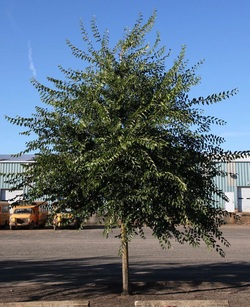
Danada Charm Elm
Zone: 4 Height: 70’ Spread: 60’ Shape: Vase shaped with arching limbs Foliage: Dark green Fall Color: Yellow DISEASE TOLERANCE: Dutch Elm Disease and phloem necrosis Long arching branches form an upright vase shape to give this cultivar the look and character of the American Elm. Naturally disease resistant, it is a vigorous grower in the nursery. 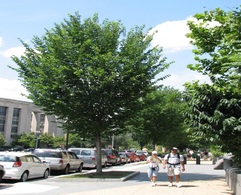
Princeton Elm
Zone: 4 Height: 65’ Spread: 50’ Shape: Upright vase shaped Foliage: Dark green Fall Color: Yellow DISEASE TOLERANCE: Dutch Elm Disease Originally selected in 1922 by William Flemer for its dense symmetrical upright form and dark green foliage, it has since proven to be one of the best American Elms for resisting the attack of Dutch Elm Disease. 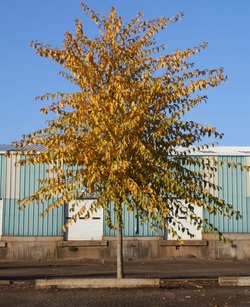
'Morton Glossy' Triumph Elm
Zone: 4 Height: 55’ Spread: 45’ Shape: Upright oval to vase Foliage: Glossy dark green Fall Color: Yellow DISEASE TOLERANCE: Dutch Elm Disease and phloem necrosis Remarkably dark green and glossy foliage and a sturdy, symmetrical growth habit distinguish this Morton Arboretum introduction. Hybrid parentage is Ulmus wilsoniana, U. japonica, and U. pumila. Honeylocust Trees (Gleditisia spp.)

Imperial Honeylocust
Zone: 4 Height: 35’ Spread: 35’ Shape: Rounded Foliage: Fine textured, medium green Fall Color: Yellow Fruit: Seedless Imperial is small and rounded, the most compact and formal of the popular Honeylocust cultivars. Wide branch angles resist storm damage and create a horizontal spreading branch pattern. 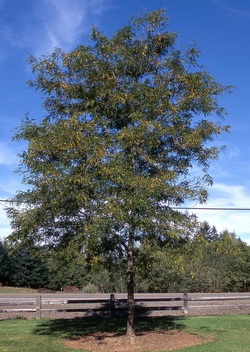
Shademaster Honeylocust
Zone: 4 Height: 45’ Spread: 35’ Shape: Vase shaped to rectangular in outline Foliage: Fine textured, medium green Fall Color: Yellow Fruit: Seedless Shademaster features upright ascending then spreading branches which produce an irregularly vase shaped form and a slightly rectangular outline. An excellent street tree, its upright branch structure lends itself to pruning for traffic clearance. 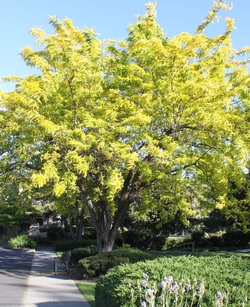
Sunburst Honey
locust Zone: 4 Height: 40’ Spread: 35’ Shape: Irregular, somewhat rectangular outline Foliage: Bright yellow tip growth Fall Color: Yellow-brown Fruit: Seedless Sunburst is used for its bright golden yellow, fine textured foliage. The new growth is always bright yellow which contrasts attractively with the darker yellow green interior foliage. 
Skyline Honey
locust* Zone: 4 Height: 45' Spread: 35' Shape: Broadly pyramidal Foliage: Fine textured, medium green Fall Color: Golden Fruit: Seedless The most widely used Honeylocust cultivar. Its upright spreading branch angles, well behaved form and environmental tolerance make Skyline an ideal street tree in many situations. 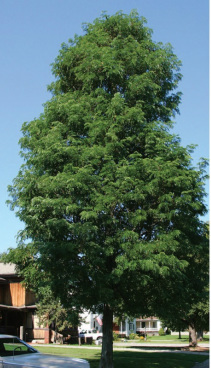
Street Keeper Honeylocust
Zone: 4 Height: 45' Spread: 20' Shape: Narrow, strongly upright, tightly pyramidal Foliage: Dark green, fine textured Fall Color: Yellow An ideal tree for city streets, this cultivar boasts the tight, narrow form that has long been lacking in urban tolerant honeylocust. The ascending branch structure gives Street Keeper a canopy that is only half as wide as other cultivars. Foliage is deeper green than other selections. Maple Trees
(Acer spp.) 
Norweigen Sunset Maple
Zone: 4b Height: 35' Spread: 25' Shape: Oval Foliage: Dark green, glossy Fall Color: Yellow-orange to red INSECT RESISTANCE: Japanese beetle An upright oval tree with yelloworange to red fall color. Norwegian Sunset has a particularly nice branch structure and uniform canopy. Its Acer truncatum parentage gives glossy foliage and heat resistance. 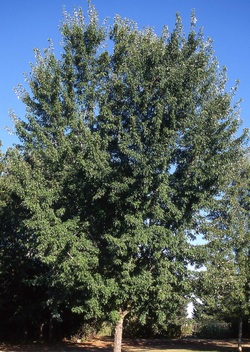
Silver Queen Maple
Zone: 3 Height: 50' Spread: 40' Shape: Oval with upright spreading branches Foliage: Medium green above, silvery beneath Fall Color: Yellow Fruit: Seedless A more refined version of Silver Maple, with a more dominant central leader and more slender branches with better crotch angles. 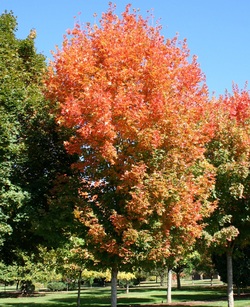
Legacy Maple
Zone: 5 Height: 50' Spread: 35' Shape: Oval Foliage: Glossy dark green Fall Color: Reddish-orange to red INSECT RESISTANCE: Japanese beetle Legacy produces a very symmetrical oval crown. This, combined with its glossy dark green leaves makes it one of the most handsome Sugar Maples in summer. Its leaves are quite tough and resist leaf tatter and drought. Zelkova Trees (Zelkova spp.)

Green Vase Zelkova
Zone: 5 Height: 45' Spread: 30' Shape: Vase shape, with upright arching branches Foliage: Green Fall Color: Orange A vigorous Zelkova selection, producing a taller, more graceful tree than ‘Village Green’. Its finer textured foliage produces dappled shade. 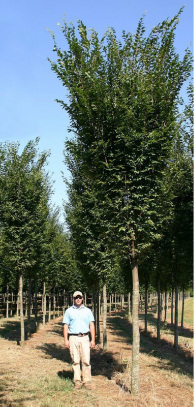
Musashino Zelkova
Zone: 5 Height: 45' Spread: 15' Shape: Very narrow upright vase shape Foliage: Medium green Fall Color: Yellow Ideal for narrow street use, tightly upright branches allow good vehicle and pedestrian clearance beneath the delicate green canopy. Plane Trees
(Platanus spp.) 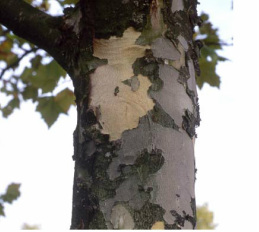
Bloodgood London Plane Tree
Zone: 5 Height: 50' Spread: 40' Shape: Broadly pyramidal Foliage: Large, maple like, medium to dark green Fall Color: Yellow Reputed to be more resistant to anthracnose than the species. The naturally shedding bark creates a dappled brown and cream pattern that accentuates sunlight filtering through the foliage. This is a popular tree for malls, parks and shopping centers. |
Less than 2 foot of typical growth per year
Oak Trees (Quercus spp.) 
Bur Oak*
Zone: 3 Height: 55’ Spread: 45’ Shape: Broad oval irregular & open. Foliage: Dark green Fall Color: Yellow to yellow brown A large and impressive native tree, with a thick trunk and stout branches. Does well in alkaline soils. 
Chinkapin Oak
Zone: 5 Height: 45' Spread: 45' Shape: Rounded,open Foliage: Lustrous dark green Fall Color: Yellow to brown A durable and adaptable oak with handsome glossy foliage. This native of the Northeast and Midwest has a reputation for performing well in alkaline soil. 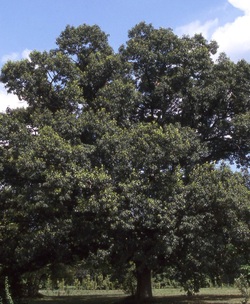
Sawtooth Oak
Zone: 5 Height: 40’ Spread: 40’ Shape: Rounded Foliage: Dark green, glossy Fall Color: Yellow A fast growing, spreading oak well adapted to the summer heat of the South. It has outstanding summer foliage. Very glossy and sharply serrated leaves give it a clean, crisp appearance. Linden Trees (Tilia spp.)
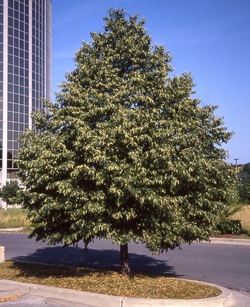
Greenspire Linden*
Zone: 4 Height: 40' Spread: 30' Shape: Pyramidal, symmetrical Foliage: Dark green Fall Color: Yellowish Greenspire is the standard of comparison among the Lindens. It has a strong central leader, very uniform branch arrangement and a symmetrical, pyramidal form. 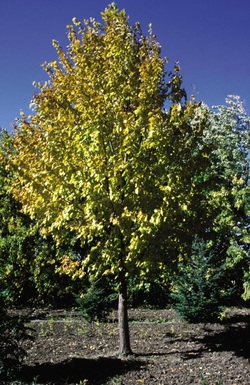
Harvest Gold Linden
Zone: 2-7 Height: 30-40' Spread: 25-30' Shape: Upright, oval Foliage: Dark green Fall Color: Golden This hybrid of Tilia cordata and Tilia mongolica was developed in Manitoba, Canada. It is hardier than Norlin linden and resistant to sun scald injury and leaf spot. An excellent boulevard tree, it has lovely exfoliating bark, golden buds and consistent fall color. 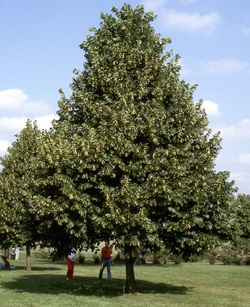
Redmond Linden
Zone: 3 Height: 35’ Spread: 25’ Shape: Densely pyramidal Foliage: Light green Fall Color: Yellowish Redmond grows rapidly and develops heavy caliper as a young tree, becoming pyramidal and symmetrical as it matures. Its large leaves give it a coarser textured appearance. Hackberry Trees (Celtis occidentalis)
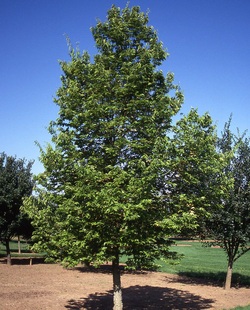
Common Hackberry*
Zone: 3 Height: 45’ Spread: 35’ Shape: Broad top with ascending, then arching branches Foliage: Light green Fall Color: Yellow Tolerant of harsh climatic conditions as well as urban abuse, this deep rooted tree rarely lifts sidewalks. The rough, corky bark adds interest and resists damage. Kentucky Coffee Trees (Gymnocladus dioicus)
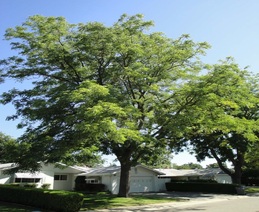
Kentucky Coffee Tree
Zone: 4 Height: 50' Spread: 35' Shape: Oval to vase shaped with upright arching branches Foliage: Huge doubly compound leaves, bluish-green Fall Color: Yellow The huge doubly compound leaves give this tree a tropical feel, and the arching branches present an elm-like form. This is a seedless selection. Good tolerance of heat, drought, and cold. |
Whartons For Every Bloomin' Thing in Western Kansas

